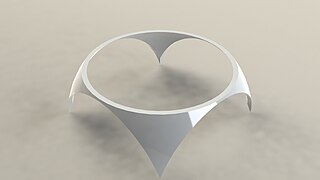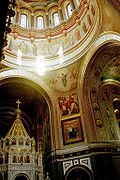Pendentive (original) (raw)
From Wikipedia, the free encyclopedia
Architectural element
Schematic representation of a dome on pendentives.

Look up pendentive in Wiktionary, the free dictionary.
In architecture, a pendentive is a constructional device permitting the placing of a circular dome over a square room or of an elliptical dome over a rectangular room.[1] The pendentives, which are triangular segments of a sphere, taper to points at the bottom and spread at the top to establish the continuous circular or elliptical base needed for a dome.[2] In masonry the pendentives thus receive the weight of the dome, concentrating it at the four corners where it can be received by the piers beneath.
Prior to the pendentive's development, builders used the device of corbelling or squinches in the corners of a room. Pendentives commonly occurred in Orthodox, Renaissance, and Baroque churches, with a drum with windows often inserted between the pendentives and the dome. The first experimentation with pendentives began with Roman dome construction in the 2nd–3rd century AD,[3] while full development of the form came in the 6th-century Eastern Roman Hagia Sophia at Constantinople.[4]

A pendentive, labelled A. Illustration of a church in Nantua.
Formation of a pendentive. Eugène Viollet-le-Duc, 1856
Pendentive structure
Arches (left and right), dome (top) and pendentive (centre) in Moscow Cathedral


One pendentive of the Hagia Sophia main dome

- History of Italian Renaissance domes
- Spandrel – Space between a curved figure and a rectangular boundary
- ^ The Columbia Encyclopedia, sixth edition
- ^ "pendentive (architecture) - Britannica Online Encyclopedia". Britannica.com. Retrieved 2012-08-15.
- ^ Rasch 1985, pp. 129f.
- ^ Heinle & Schlaich 1996, pp. 30–32
- Heinle, Erwin; Schlaich, Jörg (1996), Kuppeln aller Zeiten, aller Kulturen, Stuttgart, ISBN 3-421-03062-6
{{[citation](/wiki/Template:Citation "Template:Citation")}}: CS1 maint: location missing publisher (link) - Rasch, Jürgen (1985), "Die Kuppel in der römischen Architektur. Entwicklung, Formgebung, Konstruktion", Architectura, vol. 15, pp. 117–139
